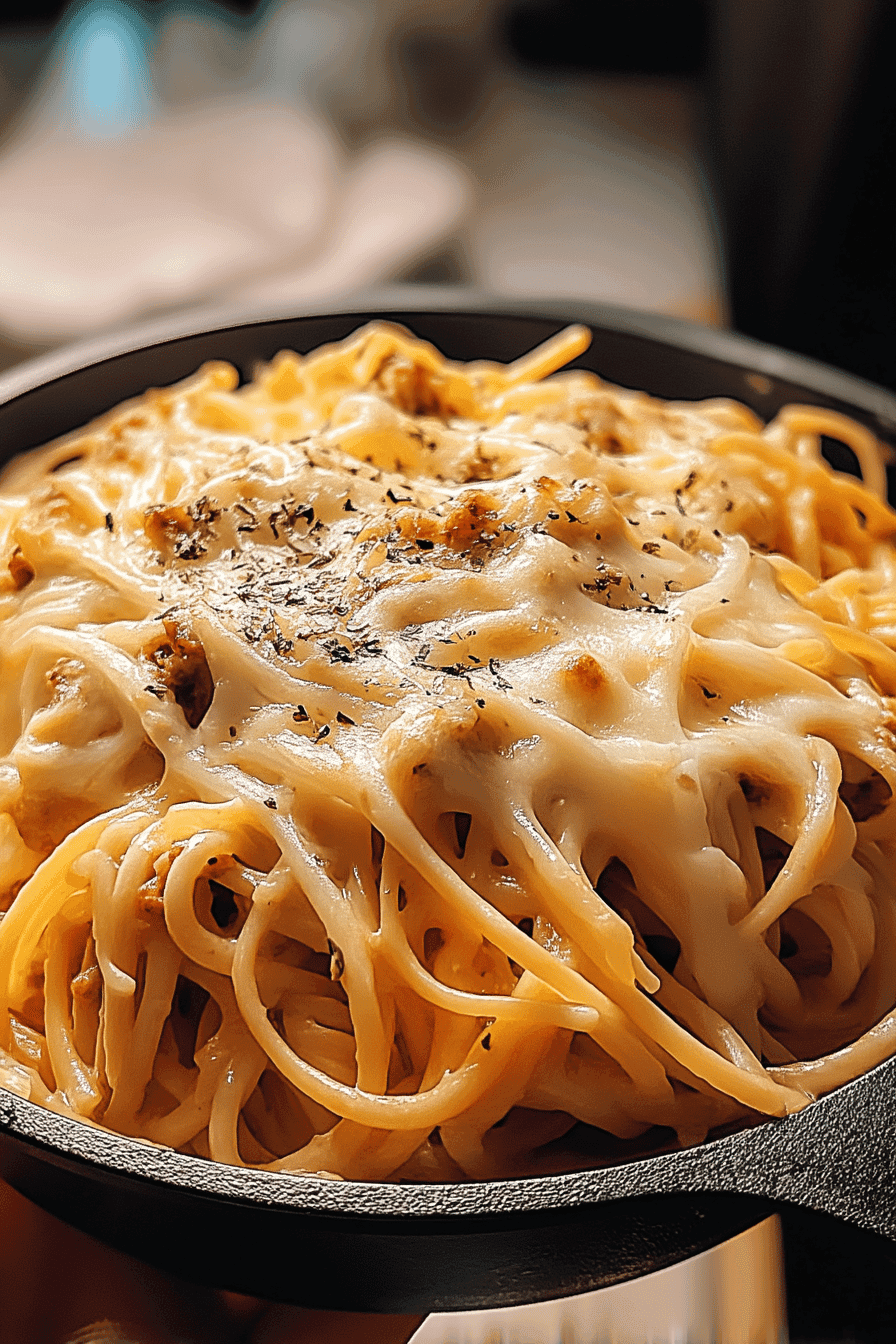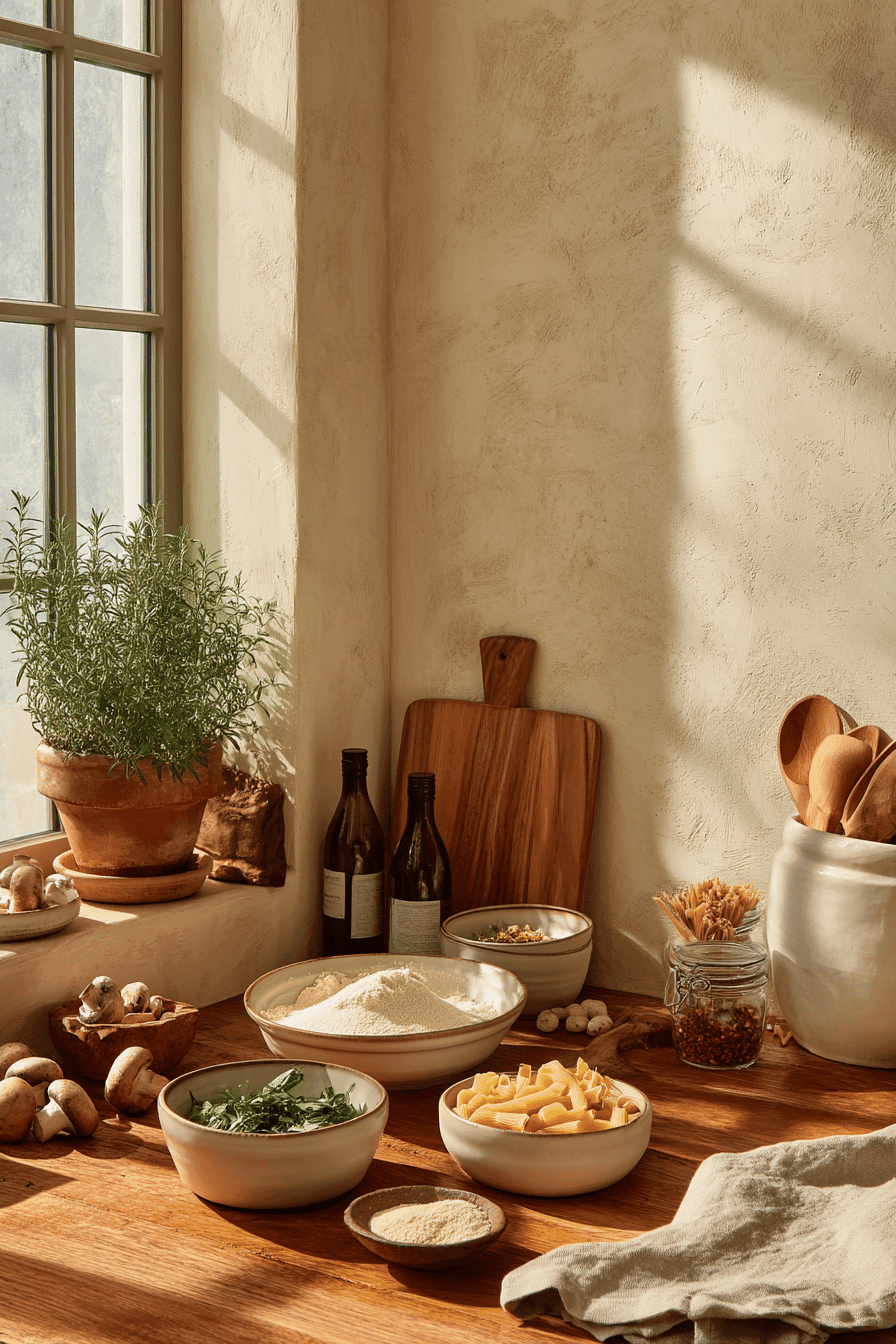Benefits and Advantages of baked cream cheese spaghetti
Baked cream cheese spaghetti is a comforting and hearty casserole that stands out for its ease of preparation and rich, creamy flavor. It offers a unique texture by blending tender spaghetti with smooth cream cheese and melty cheeses like Parmesan and mozzarella. This dish requires minimal active cooking time as the oven does most of the work, which makes it a great choice for busy home cooks and families.
From a nutritional perspective, the cream cheese adds protein and calcium, supporting a balanced diet when combined with lean ground beef and wholesome ingredients. The baked aspect creates a satisfying golden crust that many pasta dishes lack, giving a delightful mix of creamy inside and slightly crisped top.
Another advantage is its versatility. This recipe can be easily adapted for different dietary preferences by swapping ingredients like ground beef for turkey, or using gluten-free pasta. It is an excellent make-ahead meal that can be refrigerated or frozen, providing convenience for meal planning.
The simplicity, creamy richness, and hearty appeal of baked cream cheese spaghetti make it a family favorite that’s practical to prepare and enjoyable to eat on any occasion.
Jump To
- 1. Benefits and Advantages of baked cream cheese spaghetti
- 2. Essential Ingredients for baked cream cheese spaghetti
- 3. Dietary Substitutions to Customize Your baked cream cheese spaghetti
- 4. How to Prepare the Perfect baked cream cheese spaghetti: Step-by-Step Guide
- 5. Advanced Tips and Variations
- 6. How to Store baked cream cheese spaghetti: Best Practices
- 7. Nutritional Value of baked cream cheese spaghetti
- 8. FAQs: Frequently Asked Questions About baked cream cheese spaghetti
- 9. Cream Cheese Baked Spaghetti Casserole Recipe
Essential Ingredients for baked cream cheese spaghetti
This baked cream cheese spaghetti requires a handful of key ingredients that work together to deliver a flavorful and creamy casserole.
- 12 to 16 ounces (340 to 450 g) spaghetti
- 1 pound (450 g) lean ground beef
- 8 ounces (225 g) cream cheese, softened and cut into cubes
- 2 to 2.5 cups (480 to 600 ml) marinara or prepared spaghetti sauce
- 1 cup (100 g) grated Parmesan cheese
- 1 to 2 cups (100 to 200 g) shredded mozzarella or Italian blend cheese, divided
- 1 can (14 ounces / 400 g) petite diced tomatoes, undrained (optional)
- 1 to 2 cloves garlic, minced
- 1 teaspoon Italian seasoning (optional)
- Salt and pepper to taste
- Olive oil for cooking
- Fresh basil, finely chopped (optional for garnish)
These ingredients provide a balance of savory flavors, creamy texture, and cheesy richness. The lean ground beef adds protein and substance, while the blend of cheeses creates a melty, golden topping. Fresh garlic and optional Italian seasoning enhance the sauce’s flavor, complemented by the acidity from marinara and diced tomatoes.
For cooks with specialized diets, you can substitute gluten-free spaghetti or opt for a leaner meat or vegetarian alternatives to maintain this dish’s satisfying character. Fresh basil at the end adds a fragrant, fresh note that brightens each bite.
Dietary Substitutions to Customize Your baked cream cheese spaghetti
Baked cream cheese spaghetti is easily adapted to accommodate various dietary preferences or restrictions:
For Vegetarian and Vegan Diets
- Replace lean ground beef with hearty vegetables like sautéed mushrooms, bell peppers, or zucchini.
- Swap cream cheese and traditional cheeses for vegan cream cheese and plant-based mozzarella or Parmesan alternatives.
- Consider nutritional yeast as a cheesy topping alternative to add umami flavor.
For Gluten-Free Needs
- Use gluten-free pasta made from rice, quinoa, or lentils without affecting the texture significantly.
- Ensure that all sauces and seasonings are gluten-free certified to avoid cross-contamination.
For Lower-Calorie Versions
- Use reduced-fat cream cheese and lower-fat cheeses to reduce saturated fat content.
- Increase the amount of vegetables within the sauce to boost fiber and bulk while decreasing calories.
- Substitute ground beef with ground turkey or chicken breast for a leaner protein source.
For Lactose Intolerant Individuals
- Choose lactose-free cream cheese and cheeses or plant-based dairy-free alternatives.
- Use olive oil instead of butter for cooking to reduce dairy input.
These substitutions allow you to maintain the creamy, baked experience of this spaghetti dish while aligning with your dietary requirements or preferences.
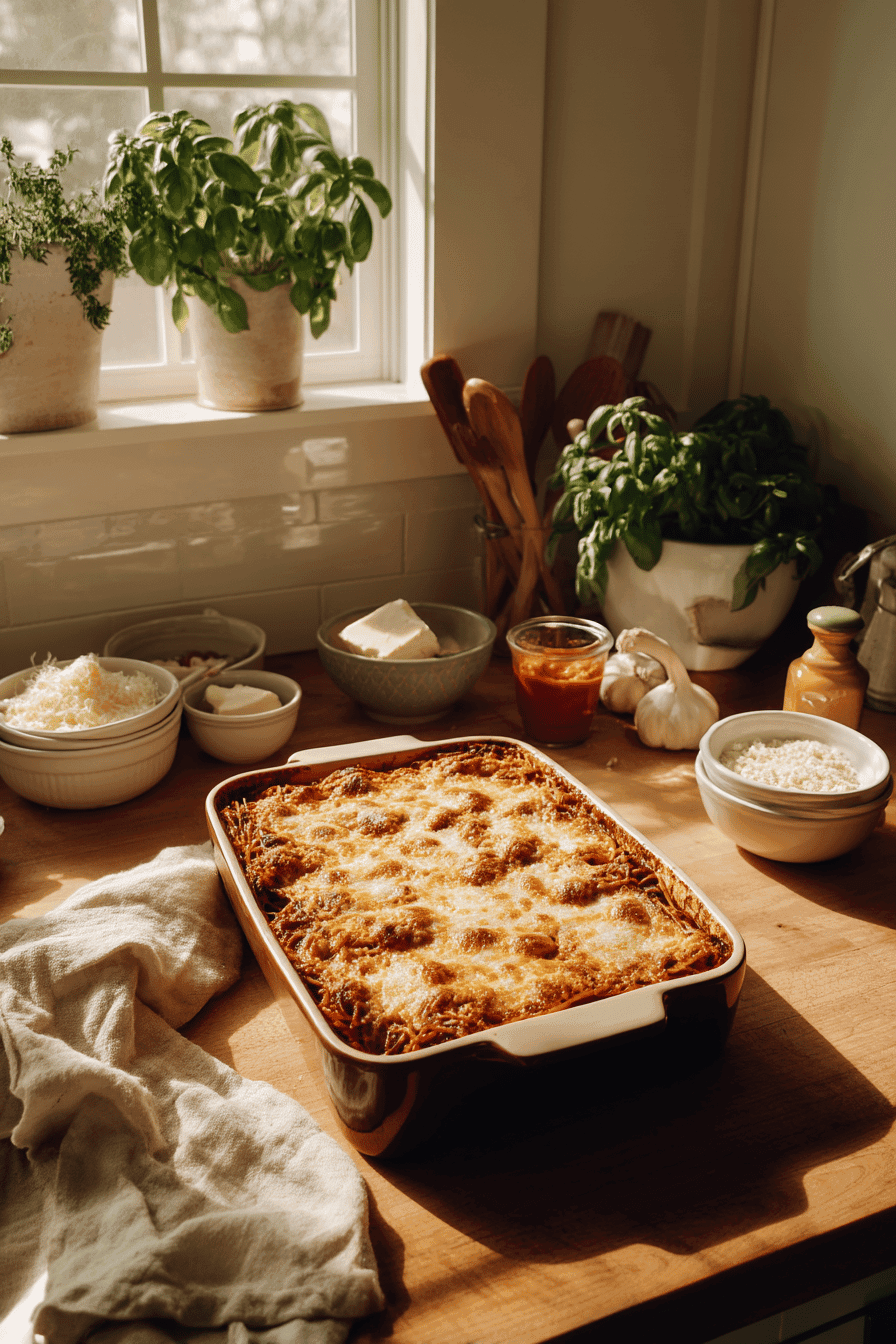
How to Prepare the Perfect baked cream cheese spaghetti: Step-by-Step Guide
- Preheat your oven to 350°F (175°C) to prepare for baking the casserole.
- Cook the spaghetti in salted boiling water until al dente according to package instructions. Drain and keep warm.
- Sauté the aromatics and beef: In a skillet, heat a small amount of olive oil over medium heat. Add minced garlic and cook until fragrant, then add lean ground beef. Brown the beef completely and drain excess fat.
- Add the sauce and seasoning: Stir marinara or spaghetti sauce, Italian seasoning (optional), and diced tomatoes (if using) into the skillet with the beef. Simmer briefly to combine flavors.
- Melt the cream cheese: In the warm pot used to cook the spaghetti, add cubed cream cheese and stir until mostly melted and creamy.
- Combine pasta and sauce: Add the cooked spaghetti to the cream cheese and stir to coat well. Then fold in the meat sauce, mixing evenly.
- Prepare for baking: Transfer the combined spaghetti and sauce mixture to a greased 9×13-inch baking dish. Sprinkle half of the shredded mozzarella or cheese blend on top.
- Bake: Bake uncovered for 20 to 30 minutes until the cheese is bubbly and golden. In the last 5 minutes, add the remaining cheese and bake until melted and browned.
- Rest and garnish: Let the casserole rest for 10 to 15 minutes after baking to set and make slicing easier. Garnish with finely chopped fresh basil if desired before serving.
Tip: Cooking spaghetti al dente prevents a mushy texture after baking, and using block cream cheese ensures the creamiest consistency.
This method results in a rich, creamy spaghetti casserole perfect for family meals or make-ahead dinners. For more comforting pasta dishes, be sure to visit my baked mac and cheese recipe, which shares a similar ease and cheesy goodness.
Advanced Tips and Variations
To make your baked cream cheese spaghetti even more delicious and tailored to your preferences, here are some advanced tips and variations you can try:
Flavor Enhancements
- Use high-quality cream cheese and fresh herbs like basil or oregano to boost flavor complexity.
- Simmer the sauce for a longer time to deepen the rich tomato and cheese flavors.
- Add sautéed vegetables such as mushrooms, spinach, or bell peppers to increase nutrition and texture variety.
- Incorporate smoked paprika or cooked bacon for a smoky twist.
Baking Tips
- To keep the casserole moist, cover the dish with foil for the first 20 minutes of baking, then uncover to brown and bubble.
- Use a blend of cheeses try provolone, gouda, or Italian blend with mozzarella and Parmesan for complex cheesy layers.
- Cook the spaghetti al dente to avoid a mushy texture after baking.
Dietary Variations
- For a vegetarian version, omit the ground beef and add vegetables like zucchini or mushrooms.
- Swap ground beef with ground turkey or chicken for a lighter protein option.
- Try whole wheat or legume-based pasta to increase fiber content.
- Use vegan cream cheese and cheeses to make a dairy-free baked spaghetti.
- Sprinkle nutritional yeast on top for a cheesy flavor without dairy.
These variations let you customize the classic baked cream cheese spaghetti to suit your taste, dietary needs, and available ingredients while keeping the creamy, comforting base intact.
How to Store baked cream cheese spaghetti: Best Practices
Proper storage helps maintain the delicious texture and safety of your baked cream cheese spaghetti.
Cooling and Refrigerating
- Allow the casserole to cool completely at room temperature before storing to avoid condensation buildup.
- Cover tightly with plastic wrap or transfer portions to airtight containers.
- Store in the refrigerator for up to 3-4 days.
Freezing Tips
- Divide the casserole into meal-sized portions before freezing for easy reheating.
- Use freezer-safe containers or heavy-duty freezer bags. Press out excess air to prevent freezer burn.
- Freeze for up to 2 months for best quality.
Reheating Instructions
- Thaw frozen portions overnight in the refrigerator.
- Warm in an oven preheated to 350°F (175°C) until heated through, about 20-30 minutes.
- Microwave is a quicker option, but reheat evenly by stirring halfway.
- Avoid reheating multiple times to preserve texture and flavor.
Following these storage guidelines helps keep your baked cream cheese spaghetti tasting fresh and safe to eat. For a cozy pasta casserole idea, see Baked Mac and Cheese on my blog.
Nutritional Value of baked cream cheese spaghetti
Baked cream cheese spaghetti is a filling dish that balances macronutrients and provides key vitamins and minerals.
| Nutrient | Approximate Amount Per Serving | Notes |
|---|---|---|
| Calories | 400-500 kcal | Depends on cheese quantity and pasta type |
| Protein | 15-20 grams | From lean ground beef and cheeses |
| Fat | 20-25 grams | Saturated fats mainly from cream cheese and mozzarella |
| Carbohydrates | 40-50 grams | Primarily from spaghetti; whole wheat increases fiber |
| Calcium | Approx. 200-300 mg | Supports bone health, from cheese |
| Sodium | 400-600 mg | Varies with cheese and sauce; monitor if sodium-sensitive |
Choosing reduced-fat cheeses and whole-grain pasta options can improve the dish’s nutritional profile by reducing saturated fat and increasing dietary fiber.
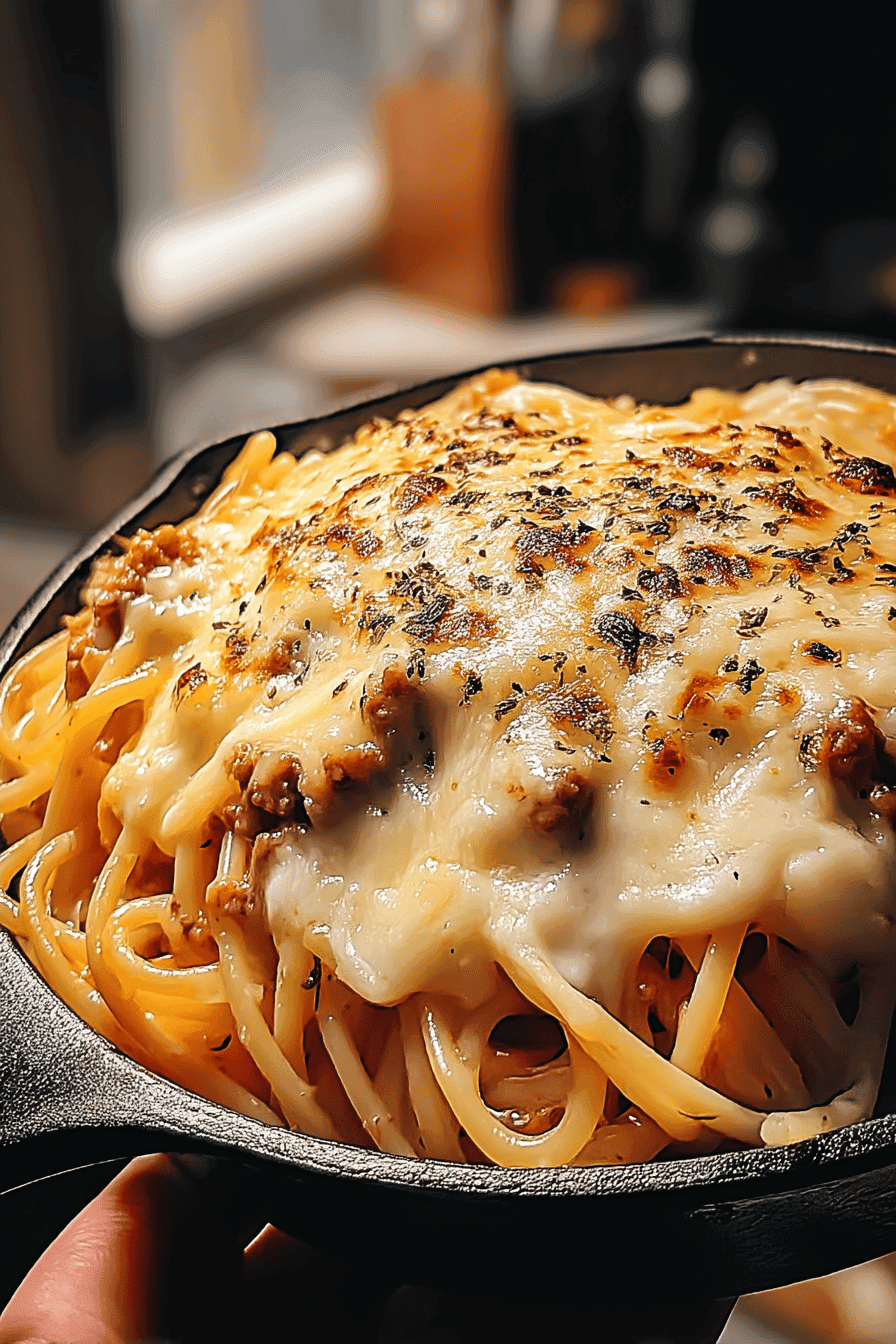
FAQs: Frequently Asked Questions About baked cream cheese spaghetti
What can I use instead of cream cheese in baked cream cheese spaghetti?
Ricotta or cottage cheese can substitute cream cheese, though they create a lighter, less dense creamy texture. Adjust quantities to about 1 to 1 2 cups and consider blending ricotta for smoothness. These options alter flavor slightly but keep the dish rich and creamy.
Can I use different types of pasta for baked cream cheese spaghetti?
Yes! Penne, rigatoni, fettuccine, or other short pasta shapes work well. Thicker pasta might require slightly longer cooking times. Using different pasta shapes also changes how the sauce clings, affecting texture and bite.
Is baked cream cheese spaghetti suitable for kids and families?
Absolutely. Its creamy, mild flavor appeals to children, and you can adjust ingredients by reducing spices or incorporating hidden veggies like spinach or bell peppers. It’s a great family meal that offers comfort and satisfying nutrition.
How can I add vegetables or extra flavor to baked cream cheese spaghetti?
Popular vegetables to add include sauteed spinach, mushrooms, bell peppers, or zucchini. Cooking these before combining with the sauce prevents extra moisture and preserves texture. Flavor boosts come from fresh herbs like basil or parsley, garlic, or a pinch of red pepper flakes for subtle heat.
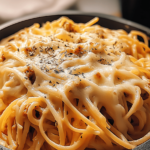
Cream Cheese Baked Spaghetti Casserole Recipe
- Total Time: 45 to 50 minutes
- Yield: 8 servings 1x
- Diet: Contains dairy and meat
Description
🍝 This Cream Cheese Baked Spaghetti Casserole blends creamy, cheesy textures with hearty ground beef for a comforting meal.
🧀 Perfect for family dinners or make-ahead meals, it offers rich flavors and easy reheating for busy nights.
Ingredients
12 to 16 ounces (340 to 450 g) spaghetti
1 pound (450 g) lean ground beef
8 ounces (225 g) cream cheese, softened and cut into cubes
2 to 2.5 cups (480 to 600 ml) marinara or prepared spaghetti sauce
1 cup (100 g) grated Parmesan cheese
1 to 2 cups (100 to 200 g) shredded mozzarella or Italian blend cheese, divided
1 can (14 ounces / 400 g) petite diced tomatoes, undrained (optional)
1 to 2 cloves garlic, minced
1 teaspoon Italian seasoning (optional)
Salt and pepper to taste
Olive oil for cooking
Fresh basil, finely chopped (optional for garnish)
Instructions
1. Preheat the oven to 350°F (175°C).
2. Cook the spaghetti in salted boiling water until al dente, then drain and set aside, keeping the pot warm.
3. In a skillet, heat olive oil over medium heat and sauté minced garlic with the ground beef until browned and cooked through. Drain any excess fat.
4. Stir in the marinara or spaghetti sauce, Italian seasoning (if using), and diced tomatoes (if desired), then simmer briefly.
5. In the warm pot, add the cubed cream cheese and stir until mostly melted.
6. Add the cooked spaghetti to the cream cheese, mixing until well coated. Then combine the spaghetti mixture with the meat sauce, ensuring even distribution.
7. Transfer the combined mixture to a greased 9×13-inch (23×33 cm) baking dish. Sprinkle half of the shredded cheese evenly on top.
8. Bake uncovered for 20 to 30 minutes until the cheese is bubbly and golden. In the last 5 minutes, sprinkle the remaining cheese and continue baking until melted and golden.
9. Let the casserole rest for about 10 to 15 minutes before serving for better texture and cleaner slices. Garnish with fresh basil if desired.
Notes
🍴 Substitute ground beef with ground turkey or chicken for a lighter version.
🥦 Make it vegetarian by omitting meat and adding vegetables like bell peppers or spinach.
🧀 Use block cream cheese for the best texture and flavor instead of whipped or tub-style.
- Prep Time: 15 to 20 minutes
- Baking Time: 20 to 30 minutes
- Cook Time: 30 minutes
- Category: Casserole
- Method: Baking
- Cuisine: Italian-American
Nutrition
- Serving Size: 1 serving
- Calories: 400-550 (estimated)
- Sugar: 6-8 grams (estimated)
- Sodium: 600-800 mg (estimated)
- Fat: 20-30 grams (estimated)
- Saturated Fat: 10-15 grams (estimated)
- Unsaturated Fat: 7-12 grams (estimated)
- Carbohydrates: 40-50 grams (estimated)
- Fiber: 3-5 grams (estimated)
- Protein: 20-25 grams (estimated)
- Cholesterol: 70-90 mg (estimated)
Keywords: Cream Cheese, Baked, Spaghetti, Casserole

